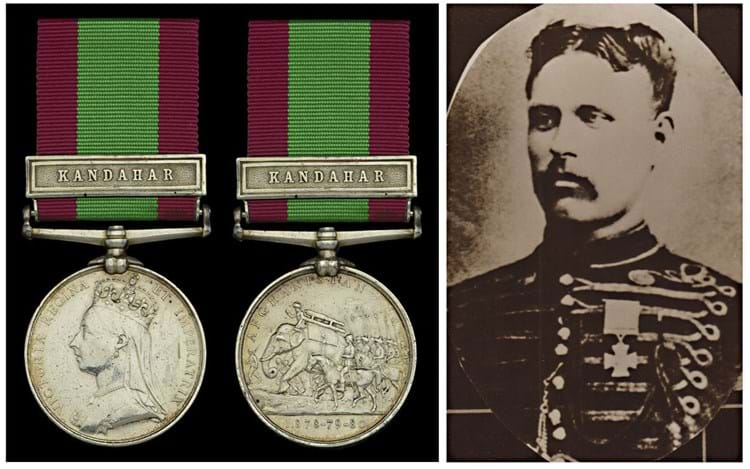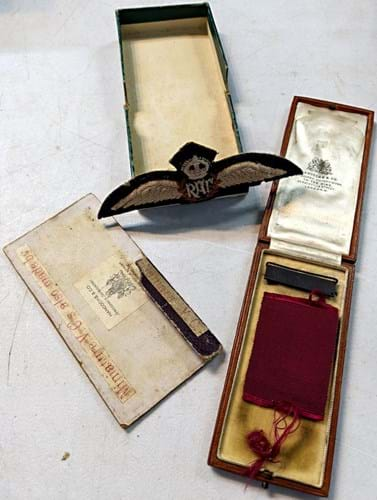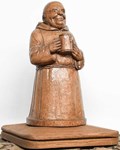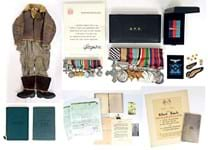
Victoria Cross winner Gunner James Collis and his Second Afghan war medal sold for £95,000 at Noonans.
Nor was there money for a headstone and he was buried in a mass grave for the poor.
Which is a strange fate for a man who won the Victoria Cross.
His remarkable story has come to light again after the sale of his Second Afghan War medal at London auction house Noonans (24% buyer’s premium) on June 21.
Gunner Collis was part of E Battery B Brigade, of the Royal Horse Artillery during the Battle of Maiwand, Afghanistan, on July 28, 1880 – a costly defeat for the British - when he showed conspicuous bravery during the retreat to Kandahar.
His courageous acts included procuring water for the wounded at great risk and saving others being carried on a gun carriage by making himself the target of a hail of bullets, and volunteering to carry a message from the beleaguered garrison to General Dewberry’s forces.
Lord Roberts presented Collis with his VC on July 11, 1881.
Wife number two
After being discharged from the army, Collis joined the Bombay Police in India. In March 1882, he married Adela Grace Skuse, a widow, returning to the UK in 1884. He re-enlisted three years later, joining the Suffolk Regiment and returned to India in 1888 as part of his service. By 1891 he was suffering from rheumatic fever and invalided home, where he journeyed without his wife.
However, in 1893 he married Mary Goddard, who was apparently unaware that he had a wife in India. In 1895 Collis was convicted of bigamy and sentenced to 18 months’ imprisonment with hard labour.
Later that year his VC was declared forfeit for his crime under the original statutes of the Royal Warrant of 1856. However, by this point, having already fallen on hard times, Collis had pawned his medal for just eight shillings.
The decoration was retrieved by police for the same sum from a pawnbroker’s shop for the Crown on the instructions of the Home Office.
After leaving prison he even re-enlisted in 1914 as a drill instructor. He was invalided out of the army on medical grounds in August 1917.
Collis died on June 28, 1918, aged 62. At his funeral at Wandsworth cemetery, his coffin was draped with the Union Flag and borne on a gun carriage escorted by a military firing party. He was given full military honours but there was no mention of his crime or the forfeiture of the VC. (A headstone was eventually erected over his burial plot in May 1998.)
Collis is one of eight VC holders whose decorations were forfeited under the authority of the Royal Warrant because each subsequently committed a crime.
Despite the family funeral snub, in 1920 his sister Hannah Haylock petitioned the War Office on behalf of the family for the forfeiture to be cancelled. King George V was sympathetic but Winston Churchill, then secretary of state for war, opposed the reinstatement.
He believed that because Collis had pawned his medals, he placed little value on them. Furthermore, Churchill noted that the family had not kept in contact with Collis, and it was only 25 years later that they had decided to raise their grievance.
Yet the king and others won the day on the wider issue and Churchill approved amendments to the rules relating to the VC which stated that henceforward only “treason, cowardice, felony or any infamous crime” should lead to forfeiture.
The king also insisted that Collis’ name should be inscribed, along with all the corps’ other VC recipients, on the Royal Artillery Memorial in Woolwich, south-east London.
Collis’ VC first appeared for sale in Colonel Gaskell’s collection at Glendining’s on May 23, 1911. It was next sold at Glendining’s on June 10, 1938, when it was bought by Colonel Oakley.
After his death it was owned by his daughter who resold it at Sotheby’s on March 21, 1979, when the VC was together with a renamed Afghanistan campaign medal.
For the next 34 years, it was held in private ownership until it was purchased by the Ashcroft Trust in 2014 and is now on display at the Imperial War Museum, still with a renamed campaign medal.
The original campaign medal awarded to Collis was never the subject of forfeit and was sold at Christie’s in July 1990.
At Noonans the estimate was £15,000-20,000 and it took £95,000 from a UK collector.
Four-figure box

RAF wings and empty Victoria Cross box with ribbon related to Lt Frank McNamara, £3300 at Bourne End Auction Rooms.
With VC values still flying high, a rather different opportunity to buy an item closely linked to the recipient but not the very expensive medal itself came up at Bourne End Auction Rooms (17.5% buyer’s premium) on June 21.
Second World War-era RAF cloth wings were offered together with a Hancocks & Co medal box containing a ribbon for the VC and named for a Lt FH McNamara VC.
Air Vice Marshal Francis Hubert (Frank) McNamara (1894-1961) was the first Australian airman to be awarded the VC. He flew with the Royal Flying Corps in the First World War and by March 1917, No 1 (Australian) Squadron was making regular bombing raids against Gaza.
The Australian War Memorial says of his VC-winning action: “On March 20 McNamara saw a fellow squadron member, Captain DW Rutherford, shot down.
Although having just suffered a serious leg wound, McNamara landed near the stricken Rutherford who climbed aboard, but his wound prevented McNamara from taking off and his aircraft crashed.”
They made it back to Rutherford’s plane which they succeeded in starting and, with McNamara at the controls, “took off just as enemy cavalry reached the scene.”
McNamara’s VC is held by the Royal Air Force Museum in north London. He retired to the UK and died in Gerrards Cross, Buckinghamshire.
When the medal box and wings were offered in the same county they made £3300 on an estimate of £30-40.
And the medal itself?
If your VC budget does stretch to a solid six figures, however, an actual medal is within reach.
On July 26 Noonans sold a First World War VC awarded to Sgt Arnold Loosemore for his great gallantry during the second Anglo- French general attack of the Third Battle of Ypres that took place south of Langemarck in Belgium on August 11, 1917.
It took a top-estimate hammer price of £220,000 from a private collector. It had been sold by the recipient’s son in 1996.
Christopher Mellor-Hill of Noonans said: “Loosemore’s medals are a phenomenal achievement with only 19 men receiving both the Victoria Cross and the Distinguished Conduct Medal during the Great War; of these, only three received the DCM after the VC, and consequently Loosemore’s DCM is just one of three to be named with the post-nominal letters VC.”














